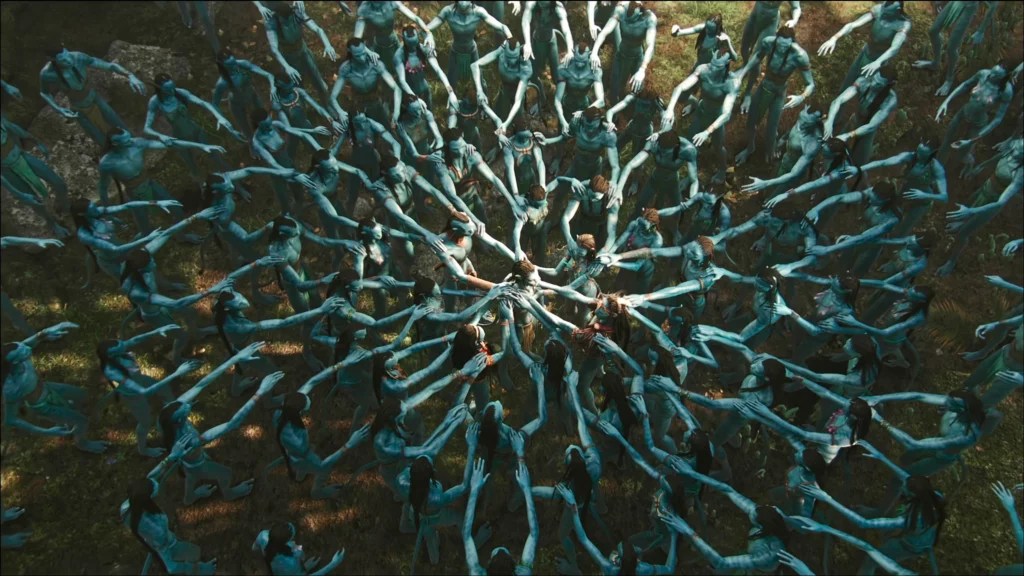Now that we’ve deep dived into how would a society led by alpha vampires looks like now let’s see how a society led by moral leaders would likely emphasize values such as justice, compassion, fairness, empathy, and integrity.
Such a society would prioritize the well-being of its members, ensuring that the needs of all, particularly the most vulnerable, are met.
Here’s one possible vision of what a society led by moral leaders could resemble. To illustrate this, we can draw a parallel with James Cameron’s Avatar.
1. Fairness and Justice

- Laws and systems would be structured to ensure equality, ensuring everyone has access to the same opportunities regardless of background, gender, race, or economic status.
- Decision-making processes would be transparent and inclusive, with an emphasis on addressing systemic inequalities and fostering social justice.
- Moral leaders would strive for restorative justice, focusing on rehabilitation over punishment and supporting second chances.
Perhaps we can truly understand a society by observing how they treat their enemies. Do they imprison them, or do they seek ways to integrate them?
This mirrors the Na’vi approach in Avatar, where they value harmony and the possibility of redemption, even for those who oppose them. Instead of simply seeking retribution, the Na’vi prioritize understanding and balance, attempting to heal divisions rather than exacerbate them.
2. Empathy and Compassion

- Policies and actions would reflect deep concern for human welfare, addressing issues like poverty, homelessness, healthcare, and education.
- The government and institutions would encourage empathy by promoting emotional intelligence, mental health care, and community building.
- People in power would actively listen to and consider the struggles and needs of those less fortunate.
One key example is the Na’vi treatment of Jake Sully, a human who initially represents an outsider threat to their people. The Na’vi, particularly Neytiri, show compassion for Jake as he grows to understand their ways.
Despite their initial distrust, they allow him to learn, adapt, and become a part of their community, seeing the potential for him to change and fight alongside them to protect Pandora.
3. Sustainability and Environmental Stewardship

- Moral leaders would recognize the importance of preserving the planet for future generations, championing sustainable practices in both government policy and business.
- The society would prioritize eco-friendly technologies, renewable energy, and protection of natural resources.
- Climate change would be addressed proactively, with moral leaders acting to mitigate harm to vulnerable communities and ecosystems.
The Na’vi live in a way that is deeply sustainable and integrated with the land around them. They hunt, gather, and live off the resources of Pandora without depleting or damaging the environment. Instead of exploiting their surroundings for short-term gain, they ensure that they only take what they need and always in a way that preserves the balance of the ecosystem.
Their culture is built around the idea of living in harmony with nature, rather than exploiting it for personal gain or development, which contrasts sharply with the humans in the film, who seek to strip Pandora of its resources without concern for the long-term consequences. The Na’vi’s sustainable practices, such as the careful management of the land, the careful consideration of animal populations, and the preservation of the planet’s natural beauty, represent a model of ecological balance and respect for the interconnectedness of all living things.
4. Education and Growth

- Education would be focused not only on academic learning but also on character development—teaching children about kindness, respect, responsibility, and critical thinking.
- Access to education would be universal and high-quality, allowing everyone to reach their full potential.
- Continuous personal and societal growth would be encouraged, with an emphasis on lifelong learning and self-improvement.
The Na’vi’s educational system is built on experiential learning, mentorship, and spiritual growth. The emphasis on connecting with nature and understanding one’s place within the broader ecosystem provides a holistic approach to personal development.
Rather than focusing on rote memorization or institutionalized knowledge, Na’vi education emphasizes wisdom, respect for others, and the cultivation of inner strength and balance. This model contrasts with more conventional human educational systems and demonstrates a path of learning that is deeply integrated with the values of empathy, interdependence, and harmony with the world.
5. Community and Collaboration

- A society led by moral leaders would value cooperation over competition, fostering a sense of collective responsibility.
- Collaboration would be central, both in the workplace and in governance. Rather than power struggles, the focus would be on teamwork and working towards common good.
- A strong sense of community would exist, with people supporting one another in times of need and working together for mutual benefit.
In Avatar, the Na’vi exemplify collaboration not only between themselves but also with the world around them. Their relationships with the Ikran, their ability to unite in the face of external threats, their respect for their elders and the spiritual guidance they provide, and their deep connection to Eywa all illustrate how collaboration is central to Na’vi culture.
Their actions demonstrate that collaboration is essential for survival, harmony, and growth. This spirit of unity and mutual respect is a key characteristic that defines the Na’vi as a society.
6. Non-Violence and Peace

- A society led by moral leaders would promote non-violent solutions to conflict, both at the individual and international levels.
- Human rights would be upheld rigorously, and conflicts would be resolved through diplomacy, dialogue, and understanding rather than war.
- Efforts to promote global peace, disarmament, and reconciliation would be a priority.
In the Na’vi society, non-violence and peace are core principles that shape their worldview and interactions with others. Their respect for all life, commitment to spiritual harmony, and emphasis on peaceful conflict resolution create a society that values the protection of balance over the pursuit of power.
While they are capable of defending themselves when necessary, their ultimate goal is to maintain peace and preserve their connection to each other and to the world around them. Through these examples, the Na’vi demonstrate how a society built on non-violence can function, even in the face of great external threats
7. Leadership by Example

- Moral leaders would be expected to set personal examples of integrity and ethical behavior, acting in a way that inspires others to do the same.
- Transparency in leadership would be a hallmark, with leaders being accountable for their actions and the decisions they make.
- Moral leaders would be motivated by the common good, avoiding personal gain and instead focusing on how their actions can improve the lives of others.
Jake Sully’s act of becoming Toruk Makto is a powerful example of leadership by example in Avatar. It shows that true leadership isn’t about wielding power over others, but about earning respect through courage, self-sacrifice, and a commitment to the greater good.
Jake doesn’t just tell the Na’vi what they should do—he shows them through his actions, proving that leadership is about guiding others by example, embodying the values you wish to promote, and acting with integrity for the sake of the community.
8. Promoting Human Rights

- A society guided by moral leaders would advocate for the dignity and rights of all people, ensuring that freedoms like speech, religion, and privacy are protected.
- Discrimination of any kind would be actively fought, and the leaders would promote inclusivity and respect for all cultures, beliefs, and identities.
Although Avatar focuses more on the Na’vi’s connection with nature and their fight to preserve their land, their treatment of individuals—both Na’vi and humans—illustrates a deep commitment to values that mirror fundamental human rights: autonomy, dignity, the right to belong, and the right to live in peace and harmony.
The Na’vi may not have formal human rights institutions as we understand them, but their societal values suggest a respect for these rights, making their culture a model of inclusion, respect for life, and protection of freedom.
9. Holistic Well-Being

- Health care would not be a commodity but a right, with accessible and effective services available to everyone.
- People’s mental, physical, and emotional well-being would be prioritized equally, and initiatives for mental health awareness and support would be part of public life.
- Work-life balance and the personal fulfillment of citizens would be taken into account in policy making.
In the Na’vi community, holistic well-being is about finding balance in all aspects of life—physical health, mental clarity, emotional fulfillment, and spiritual connection. Their way of life, deeply intertwined with nature, community, and respect for the interconnectedness of all things, offers a model of holistic well-being that is rare in modern societies.
It highlights the importance of maintaining balance not only within oneself but also in one’s relationship with the environment and others, demonstrating the profound impact of living in harmony with the world around you.
10. Balanced Power

- Moral leaders would not seek to consolidate their power but would strive for checks and balances, ensuring that no one person or group has too much influence.
- There would be mechanisms in place to prevent corruption and power abuse, with an active and informed citizenry capable of holding leaders accountable.
In Na’vi society, the balance of power is maintained through mutual respect, spiritual guidance, collective decision-making, and a deep connection to nature. Power is not concentrated in the hands of a single leader or group but is instead distributed across generations and guided by a sense of duty to the people and the land.
This balance ensures that power is exercised responsibly, in accordance with the values of the Na’vi, and that the well-being of both the individual and the community remains at the forefront of all decisions.
Potential Challenges:
While a society led by moral leaders may seem ideal, challenges would undoubtedly arise:
- Moral Dilemmas: Leaders would have to navigate complex ethical questions, and what is considered “moral” might vary from person to person or culture to culture.
- Compromise and Conflict: Balancing competing interests and values could lead to tension, especially when moral principles clash with practical or economic realities.
- Human Nature: Even moral leaders would have to grapple with the limitations and imperfections of human nature, which can sometimes lead to lapses in judgment or ethical failings.
- Competing society: A holistic society, grounded in ethical principles, resilience, and innovation, could be victim of a technologically superior tyrannical regime.
Conclusion

In a society led by moral leaders, the focus would be on building a world based on justice, fairness, empathy, and collaboration.
By prioritizing human dignity, collective well-being, and sustainable practices, such a society would embody the best aspects of humanity, creating a place where individuals can thrive in harmony with one another and the world around them.
While challenges would inevitably arise, the guiding principles of compassion and moral leadership would ensure that this society remains focused on fostering an environment of peace, equity, and mutual respect.
In this society, the vision would be that the success of a nation or community is measured not by GDP or material wealth, but by the happiness, well-being, and sustainability of its people and environment. Leaders would guide their people towards a future where humanity’s best qualities are fully realized, and the common good is the driving force behind all decisions.


GIPHY App Key not set. Please check settings